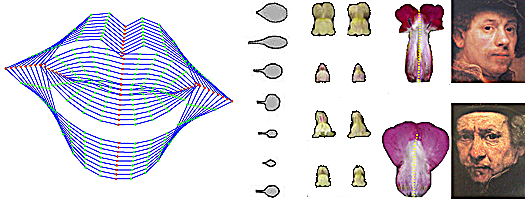AAMToolbox Details: Difference between revisions
Jump to navigation
Jump to search
| Line 5: | Line 5: | ||
However, the shapes of biological organs rarely make measurement simple - how do you measure the two or three dimensional (2 or 3D) shape of an ear, leaf or Snapdragon flower? We do it by | However, the shapes of biological organs rarely make measurement simple - how do you measure the two or three dimensional (2 or 3D) shape of an ear, leaf or Snapdragon flower? We do it by | ||
*digitising the outlines using, for example, ''VolViewer'' | *digitising the outlines using, for example, ''VolViewer'' | ||
*averaging the shapes of many examples (Procrustes) then find the principle components that contribute to variations from the mean shape. For this we use the ''AAMToolbox''. | *averaging the shapes of many examples ('''Procrustes''') then find the '''principle components''' that contribute to variations from the mean shape. For this we use the ''AAMToolbox''. | ||
[[image:Various shapes.png|400px|center|Shape and appearance models]]Left - lip outlines vary along the first principle component. Next - leaf and petal shapes. Right - Rembrandt's self portraits vary. | [[image:Various shapes.png|400px|center|Shape and appearance models]]Left - '''lip outlines''' vary along the first principle component. Next - '''leaf and petal''' shapes. Right - Rembrandt's '''self portraits''' vary. | ||
Revision as of 14:03, 28 November 2013
Shape modelling: what is the AAMToolbox and why'?
We wish to understand how biological organs grow to particular shapes. For this we need a tool to help us think through what we expect to see (GFtbox) and we need to make measurements of real biological organs to test our expectations (hypotheses).
However, the shapes of biological organs rarely make measurement simple - how do you measure the two or three dimensional (2 or 3D) shape of an ear, leaf or Snapdragon flower? We do it by
- digitising the outlines using, for example, VolViewer
- averaging the shapes of many examples (Procrustes) then find the principle components that contribute to variations from the mean shape. For this we use the AAMToolbox.

Left - lip outlines vary along the first principle component. Next - leaf and petal shapes. Right - Rembrandt's self portraits vary.